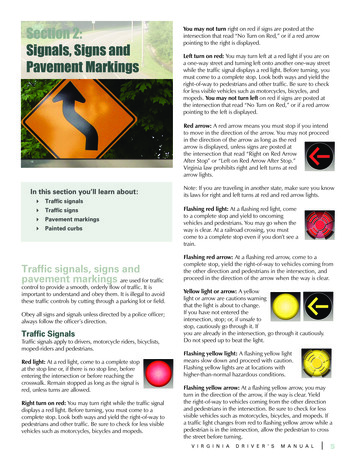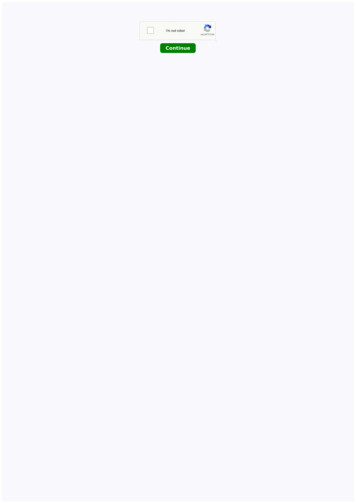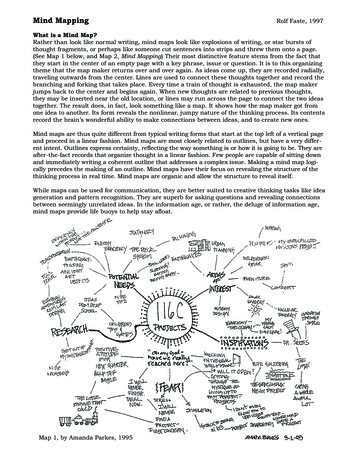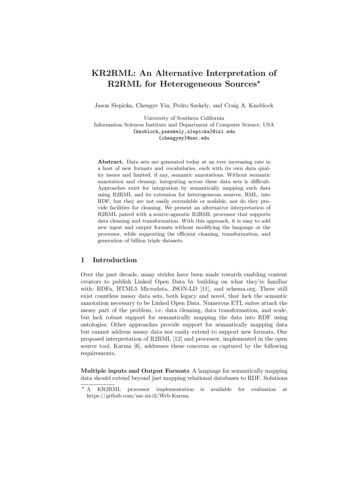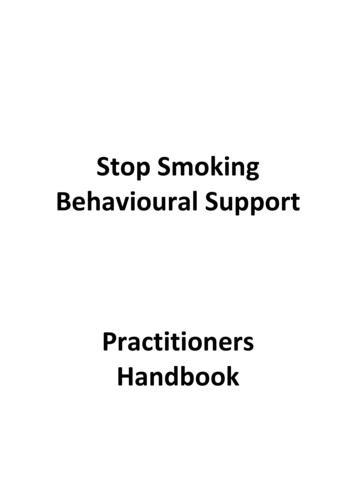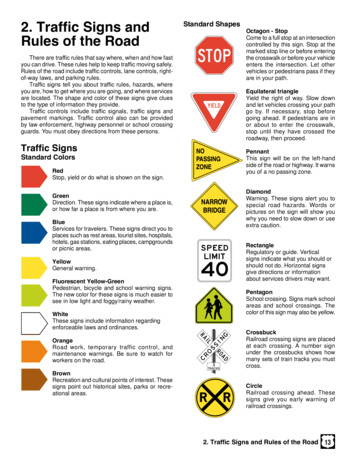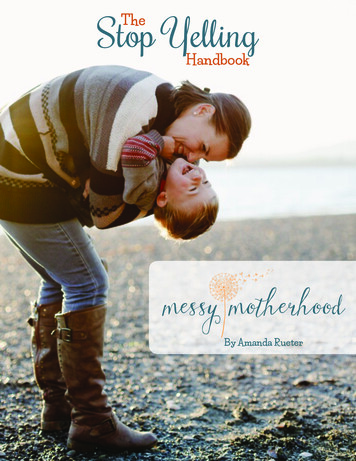
Transcription
Stop YellingTheHandbookBy Amanda Rueter 2017 Messy Motherhood
Copyright 2016 by Amanda Rueter of DirtAndBoogers.com. All rights reserved.You are welcome to print a copy of this document for your personal use. Other thanthat, no part of this publication may be reproduced, stored, or transmitted in any formor by any means, electronic, mechanical, photocopying, recording, scanning, orotherwise, except as permitted under Section 107 or 108 of the 1976 United StatesCopyright Act, without the prior written permission of the author. Requests to theauthor and publisher for permission should be addressed to the following email:amanda@dirtandboogers.com.Limitation of liability/disclaimer of warranty: While the publisher and author have usedtheir best efforts in preparing this guide and workbook, they make no representationsor warranties with respect to the accuracy or completeness of the contents of thisdocument and specifically disclaim any implied warranties of merchantability or fitnessfor particular purpose. No warranty may be created or extended by salesrepresentatives, promoters, or written sales materials.The advice and strategies contained herein may not be suitable for your situation. Youshould consult with a professional where appropriate. Neither the publisher norauthor shall be liable for any loss of profit or any other commercial damages,including but not limited to special, incidental, consequential, or other damages.Due to the dynamic nature of the Internet, certain links and website informationcontained in this publication may have changed. The author and publisher make norepresentations to the current accuracy of the web information shared. 2017 Messy Motherhood
Table of ContentsInstructionsPg. 4The Anger ScalePg. 750 Calm Down TipsPg 8ABCs of YellingPg. 9Physical ReminderPg. 10Identifying Underlying Anger Pg. 11Tracking TriggersPg. 12The Yelling ChartPg. 13Art of ApologyPg. 14 2017 Messy Motherhood
1InstructionsThank you so much for purchasingthis handbook, it’s packed full of tipsand worksheets that can help you onyour journey to stop yelling at yourchildren.First of all, I need you to know thateven with the help of this handbook,you’ll probably yell every once in awhile, and that’s okay.I know, I know. You’re thinking, “butAmanda, I bought this handbook tohelp me stop! You’re telling me thatI’ll still yell?!” Yep, that’s what I’msaying. And here’s why.You are human and you get angry,and you make mistakes. It happens.But, the last thing I want you to do isto feel angry at yourself and so guiltridden that you stop trying. You arelearning something new, you’rechanging your behaviors, and thattakes time. We learn from ourmistakes, so it’s okay if you don’tstop yelling right away. The goal ofthis handbook is to help you becomemore aware of your anger andyelling, and to help you learn how tocontrol it so that it doesn’t overtakeyour life.The goal is for you to yell less oftenand with less intensity than you donow.With the help of thishandbook, you soon won’t be able toremember the last time you yelled atyour children. And, if you do yellagain, it won’t be as intense.This handbook can help you on yourjourney to stop yelling.Below, is a list of the handouts included, as well asinstructions on how to use each one.The Anger ScaleBefore we can stop yelling, we have to be aware of our body’s reaction to anger. Bybeing aware of the anger creeping in, we can stop the anger explosion in its tracks.On this sheet, you’ll understand exactly how it feels when anger builds and you’lllearn when to start implementing calm down tips. 2017 Messy Motherhood
150 Calm Down TipsWhen you start to feel anger rise, it’s important to begin calming techniques beforeyour mind is flooded with anger. Try out a few of these when you notice yourselfgetting to a level 3, once you’re up into a level 5 on the anger scale, it’s time toremove yourself and take a break.ABCs of YellingPrint this poster out and hang it somewhere in your home, I suggest the kitchen.Use this handout when your anger has been triggered. A – Awareness. The AngerScale helps you be aware of when anger begins. When you feel anger building it’stime to B – Breathe. You must stop before the anger explodes and implement afew calm down tips. C – Calmly Take Action. Only take action to address thesituation that’s triggered your anger after you’re calmer.Physical RemindersThis handout teaches you all about physical reminders. You’ll learn what they areand how to pick the best reminders for you.Identifying Underlying AngerAnger explosions happen because of lots of little irritations and stress that up buildover time. You may think that you’re yelling because of one specific thing thathappened to you, but there’s so much more under the surface that you might noteven be aware of. This handout will help you be aware of the little things that buildand build until you explode. 2017 Messy Motherhood
1Triggers TrackerDiscover the things that make you scream! These are the big triggers, that we allhave, that cause us to jump straight to anger. This handout will help you see what’striggering your anger.The Yelling ChartIt’s time for some positive reinforcement. This is your daily sticker chart. At theend of every day, you get to decide if you’ve earned a sticker for not yelling that day.I know it might sound silly to give yourself a sticker chart, but trust me, it works.Just try it for a few days and you’ll see. I’ve seen people use this chart with theirkids, where they ask their child if they earned a sticker for the day. It’s a fun way toinclude the whole family in your journey. *Don’t have stickers? A little checkmarkworks well too.The Art of ApologyLike I said, you’ll probably yell again. There are times when life gets hard and youmight raise your voice again. Then what? Growing up, my Mama used to say “Sorryisn’t good enough.” Well, she was right. A flippint, “sorry”, really isn’t goodenough, neither is just ignoring that the yelling never happened. We must talkabout it and apologize. This handout will teach you how to make a truly heartfeltapology. Don’t skip this step, it’s important!Okay, get on with it! Flip to the next page to start your journey to stop yelling. Ifyou get stuck or have any questions along the way, send me an email toamanda@dirtandboogers.com and I’ll help you out. 2017 Messy Motherhood
2The Anger ScaleLevel One:You are happy, calm, cool relaxed. Maybe evenlaughing. Life is good. Your heart rate andbreathing are both slow and steady.Level Two:Still pretty relaxed, but might start feeling a bitannoyed by something, but you handle it withease. Your heart rate and breathing are stillslow.Level Three:Starting to feel agitated. You feel a bit tense inyour muscles, your heart rate starts to pick up.You aren’t yelling yet, but you maybe snappingat people, making demands, and rolling youreyes.Level Four:You’re feeling angry now. Your body is tenseand you can feel the anger in your muscles.Your heart rate is picking up a bit more. Yourteeth and hands maybe clenched. You’reprobably yelling and it’s hard to sit still so youmight start pacing or cleaning.Level Five:Feeling rage. Your body is so tense that you feelthe need to throw things. You’re heart beat isracing and your face maybe red. You’re sweatingand your palms and teeth are clenched. You arenot only yelling, but ranting and raving. Youare so angry that you can’t think straight. 2017 Messy Motherhood
350 Calm Down TipsMovePlayStart doing jumping jacksShake your arms and legsGo for a walkGo kick or throw a ball outsideStart cleaning somethingJump up and downDo push upsTap your hands on the table over and overChew on a piece of gumFidget with somethingRun in placeGive your kids a really big hugPut on music and have a dance partyPlayfully chase your kids around the roomMake funny soundsStart wrestling with your kidsMake silly faces at your kidsGive a piggy back rideHave a tickle fight with your kidsColor in a coloring bookLay down on the floor and play deadBlow bubblesRelaxGet it OutTalkCrazy IdeasTake some deep, cleansing breathsTense your body and releaseWalk awaySqueeze a stress ballListen to calming musicTake a break and lay downClose your eyes relax your bodyMake a calm down bottle and look at itTake a hot showerMake a long shhhh soundCall a friendStart countingTell your kids how you feelSay to yourself, “I am calm” or “I can dothis” or “I love my kids”Silently screamSing loudly to a great songScream in a pillowCry.it's okay to let them see you get upsetLaugh out loudYell outsideTear apart paper or a magazineWrite out your feelings in a journalScream “I LOVE YOU” to your kidsPretend you’re on camera or that someone iswatching youBlow up a balloonWhisperLook at a favorite picture of your kidsCuddle a baby doll or stuffed animal andsway back and forth 2017 Messy Motherhood
4ABCs of YellingWhen I start feeling angry, I will . . .AssesstheSituationBreathe!CalmlyTakeAction 2017 Messy Motherhood
5Physical RemindersOne of my favorite stop yelling tips is the use ofphysical reminders.Physical reminders are simple tokens to remind you to calm down when you startto feel angry.They work best when placed somewhere where you usually yell (dinner table,bedtime, rear-view mirror in car, going out the door, and so on) – or they can bethings that you wear so you have them with you all the time.When I made the commitment to stop yelling, I placed yellow hearts all over myhouse as a physical reminder to stop yelling. Some people wear a necklace or ringsas reminders.Here are a few good examples of physical reminders:Wear a temporary tattoo on the inside of your wristHave a special ring or braceletPut a safety pin or paper clip on the armband of your shirtWear a rubberband around your wristPaint a fingernail a certain colorPut up yellow hearts in places where you are triggeredPut up photos of your childrenPut up a favorite quote that will remind you to stop yellingWhatever you decide your physical reminders should be,make them personal to you and use them every day. 2017 Messy Motherhood 2016 DirtAndBoogers
Underlying Anger6When we get angry, there’s usually more going on underneath our anger. It’snormal for small underlying agitations and stress build and build until finally weexplode. This list will help you identify some of the small things that frustrate youso you can be aware of them.Circle the ones that affect you.SensoryBasic Needs Not MetStressToo hotUnshoweredFinancial ConcernsToo coldHungryTouched too muchTiredDisagreements withothers (spouse, friends,family)Uncomfortable clothingDehydratedToo loudAny physical painToo brightHave to go to thebathroomItchy skinToo much to doWorry and anxietyJob stressBig changes like newbabies, moves, divorce, ordeath of a loved onWrite out any other underlying agitations that make you feel uncomfortable andstressed.Take a few minutes and think about how you can eliminate some of these thingsso that they don’t agitate you. (for example: turning off all background noisewhen your kids are home or asking for help with some of your stress). 2017 Messy Motherhood
7Day, TimeTracking TriggersWho did Iyell at?Whatmade meangry?What wasI doing?Were myWas IMychildrenhungry orthoughtshungry ortired?tired? 2017 Messy MotherhoodPossibletrigger
The Yelling Chart8MonTuesWedThurs 2017 Messy MotherhoodFriSatSun
9The Art of ApologyA bit of truth: You will probably yell at your kids.We aren’t perfect and sometimeswe yell. The challenge here is to yell less often and with less intensity (rage). What doyou do after you yell? Do you do nothing and pretend that it didn’t happen? Do youapologize for yelling, or do you shift the blame back onto your kids?Think about it for a minute.Do you ever say, “you made me yell” or “if you wouldhave just then I wouldn’t have yelled at you”?Now think about this.Do you want your children to place blame on others for theirown behavior? “He hit me first, so I hit him back. It’s not my fault!” My guess is thatyou don’t like it when your child blames others for their own behavior. We teachchildren how to take responsibility by modeling it for them.So let’s practice on how we apologize for our behavior, so that our children can learn totake responsibility for their own actions.Listen tothisapology:“I’m sorry I yelled, I should not have donethat. I got upset when we’re running latebecause being late really frustrates me. Ishould not have yelled, and I’m sorry forthat. What can we do next time so that wearen’t running late?” 2017 Messy Motherhood
9Let’s break it down.1Apologize for what you did.“I’m sorry I yelled.”2Say what made you angry.“I get upset when we’re running late because being latereally frustrates me.”3Apologize again for yelling.“I should not have yelled, and I’m sorry.”4Don’t place blame on your child for yelling.*Very Important*5Problem solve and work with your child onthe issues that made you angry.“What can we do next time so that we aren’t running late?”More Examples of well-crafted apologies“I’m sorry I yelled. I get extremely angry when I see my child get hurt. Iknow you were angry, but it’s not okay to hit your brother. I should nothave yelled, and I’m sorry for that. So, let’s talk about what else youcan do besides hitting your brother, and how you can apologize to him.”“I’m sorry I yelled. I’m really upset about some things and I took it outon you. I’m so sorry.” 2017 Messy Motherhood
9“I’m sorry I yelled. It makes me frustrated when I ask you to dosomething and it doesn’t get done. It makes me feel like I’m beingignored, and that really makes me angry. I should not have yelled, andI’m sorry about that, I’ll try to react better next time. Now, let’s talkabout why you chose to not listen.”Try this: Take a minute and think about the last time you yelled at your child.out a well-crafted apology on the lines below: 2017 Messy MotherhoodWrite
Thank You!Thank you again for purchasing this Stop Yelling Handbook. I hope that it’shelped you stop the yelling.Need more support? Check out my Stop Yelling Course, Mama’s AngerManagement. It has even more insight, tips and techniques that will help youbecome the calm, happy parent that you’ve always wanted to be.Check out ent/ formore information.Warmly,Amanda Rueter 2017 Messy Motherhood
this handbook, it's packed full of tips and worksheets that can help you on your journey to stop yelling at your children. First of all, I need you to know that even with the help of this handbook, you'll probably yell every once in a while, and that's okay. I know, I know. You're thinking, "but Amanda, I bought this handbook to



